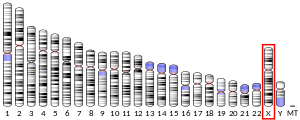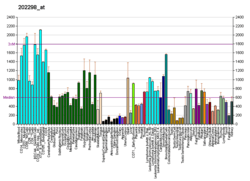NADH dehydrogenase (ubiquinone), alpha 1
NADH dehydrogenase [ubiquinone] 1 alpha subcomplex subunit 1 is a protein that in humans is encoded by the NDUFA1 gene.[4][5] The NDUFA1 protein is a subunit of NADH dehydrogenase (ubiquinone), which is located in the mitochondrial inner membrane and is the largest of the five complexes of the electron transport chain.[6] Mutations in the NDUFA1 gene are associated with mitochondrial Complex I deficiency.[5]
| NDUFA1 | |||||||||||||||||||||||||
|---|---|---|---|---|---|---|---|---|---|---|---|---|---|---|---|---|---|---|---|---|---|---|---|---|---|
| Identifiers | |||||||||||||||||||||||||
| Aliases | NDUFA1, CI-MWFE, MWFE, ZNF183, NADH dehydrogenase (ubiquinone), alpha 1, NADH:ubiquinone oxidoreductase subunit A1, MC1DN12 | ||||||||||||||||||||||||
| External IDs | OMIM: 300078 MGI: 1929511 HomoloGene: 3337 GeneCards: NDUFA1 | ||||||||||||||||||||||||
| |||||||||||||||||||||||||
| |||||||||||||||||||||||||
| Orthologs | |||||||||||||||||||||||||
| Species | Human | Mouse | |||||||||||||||||||||||
| Entrez | |||||||||||||||||||||||||
| Ensembl |
| ||||||||||||||||||||||||
| UniProt | |||||||||||||||||||||||||
| RefSeq (mRNA) | |||||||||||||||||||||||||
| RefSeq (protein) | |||||||||||||||||||||||||
| Location (UCSC) | Chr X: 119.87 – 119.88 Mb | n/a | |||||||||||||||||||||||
| PubMed search | [2] | [3] | |||||||||||||||||||||||
| Wikidata | |||||||||||||||||||||||||
| |||||||||||||||||||||||||
Structure
The NDUFA1 gene is located on the long q arm of the X chromosome at position 24 and it spans 5,176 base pairs.[5] The NDUFA1 gene produces an 8.1 kDa protein composed of 70 amino acids.[7][8] NDUFA1 is a subunit of the enzyme NADH dehydrogenase (ubiquinone), the largest of the respiratory complexes. The structure is L-shaped with a long, hydrophobic transmembrane domain and a hydrophilic domain for the peripheral arm that includes all the known redox centers and the NADH binding site.[6] NDUFA1 is one of about 31 hydrophobic subunits that form the transmembrane region of Complex I. It has been noted that the N-terminal hydrophobic domain has the potential to be folded into an alpha helix spanning the inner mitochondrial membrane with a C-terminal hydrophilic domain interacting with globular subunits of Complex I. The highly conserved two-domain structure suggests that this feature is critical for the protein function and that the hydrophobic domain acts as an anchor for the NADH dehydrogenase (ubiquinone) complex at the inner mitochondrial membrane.[5]
Function
The human NDUFA1 gene codes for a subunit of Complex I of the respiratory chain, which transfers electrons from NADH to ubiquinone.[5] However, NDUFA1 is an accessory subunit of the complex that is believed not to be involved in catalysis.[9] Initially, NADH binds to Complex I and transfers two electrons to the isoalloxazine ring of the flavin mononucleotide (FMN) prosthetic arm to form FMNH2. The electrons are transferred through a series of iron-sulfur (Fe-S) clusters in the prosthetic arm and finally to coenzyme Q10 (CoQ), which is reduced to ubiquinol (CoQH2). The flow of electrons changes the redox state of the protein, resulting in a conformational change and pK shift of the ionizable side chain, which pumps four hydrogen ions out of the mitochondrial matrix.[6]
Clinical significance
Mitochondrial complex I deficiency (MT-C1D) is caused by mutations affecting the NDUFA1 gene. Complex I deficiency is a disorder of the mitochondrial respiratory chain that causes a wide range of clinical manifestations, from lethal neonatal disease to adult-onset neurodegenerative disorders. Phenotypes include macrocephaly with progressive leukodystrophy, non-specific encephalopathy, cardiomyopathy, myopathy, liver disease, Leigh syndrome, Leber's hereditary optic neuropathy, and some forms of Parkinson's disease.[5][9] Mutations on the X chromosome that affect this gene have included the G94C mutation, which has been associated with lactic acidosis, hypotonia, increased beta-hydroxybutyrate/acetoacetate ratio, and complex I deficiency.[10]
Interactions
NDUFA1 has been shown to have 7 binary protein-protein interactions including 3 co-complex interactions. NDUFA1 appears to interact with GOLGB1, TRIM63, and SMURF2.[11]
References
- GRCh38: Ensembl release 89: ENSG00000125356 - Ensembl, May 2017
- "Human PubMed Reference:". National Center for Biotechnology Information, U.S. National Library of Medicine.
- "Mouse PubMed Reference:". National Center for Biotechnology Information, U.S. National Library of Medicine.
- Zhuchenko O, Wehnert M, Bailey J, Sun ZS, Lee CC (November 1996). "Isolation, mapping, and genomic structure of an X-linked gene for a subunit of human mitochondrial complex I". Genomics. 37 (3): 281–8. doi:10.1006/geno.1996.0561. PMID 8938439.
- "Entrez Gene: NDUFA1 NADH dehydrogenase (ubiquinone) 1 alpha subcomplex, 1, 7.5kDa".
- Donald Voet; Judith G. Voet; Charlotte W. Pratt (2013). "18". Fundamentals of biochemistry : life at the molecular level (4th ed.). Hoboken, NJ: Wiley. pp. 581–620. ISBN 9780470547847.
- Zong NC, Li H, Li H, Lam MP, Jimenez RC, Kim CS, Deng N, Kim AK, Choi JH, Zelaya I, Liem D, Meyer D, Odeberg J, Fang C, Lu HJ, Xu T, Weiss J, Duan H, Uhlen M, Yates JR, Apweiler R, Ge J, Hermjakob H, Ping P (October 2013). "Integration of cardiac proteome biology and medicine by a specialized knowledgebase". Circulation Research. 113 (9): 1043–53. doi:10.1161/CIRCRESAHA.113.301151. PMC 4076475. PMID 23965338.
- "NDUFA1 - NADH dehydrogenase [ubiquinone] 1 alpha subcomplex subunit 1". Cardiac Organellar Protein Atlas Knowledgebase (COPaKB).
- "NDUFA1 - NADH dehydrogenase [ubiquinone] 1 alpha subcomplex subunit 1". UniProt: a hub for protein information. The UniProt Consortium. Retrieved 24 March 2015.
- Mayr JA, Bodamer O, Haack TB, Zimmermann FA, Madignier F, Prokisch H, Rauscher C, Koch J, Sperl W (August 2011). "Heterozygous mutation in the X chromosomal NDUFA1 gene in a girl with complex I deficiency". Molecular Genetics and Metabolism. 103 (4): 358–61. doi:10.1016/j.ymgme.2011.04.010. PMID 21596602.
- "7 binary interactions found for search term NDUFA1". IntAct Molecular Interaction Database. EMBL-EBI. Retrieved 2018-08-25.
Further reading
- Smeitink J, van den Heuvel L (June 1999). "Human mitochondrial complex I in health and disease". American Journal of Human Genetics. 64 (6): 1505–10. doi:10.1086/302432. PMC 1377894. PMID 10330338.
- Tretter L, Sipos I, Adam-Vizi V (March 2004). "Initiation of neuronal damage by complex I deficiency and oxidative stress in Parkinson's disease". Neurochemical Research. 29 (3): 569–77. doi:10.1023/B:NERE.0000014827.94562.4b. PMID 15038604.
- Frattini A, Faranda S, Bagnasco L, Patrosso C, Nulli P, Zucchi I, Vezzoni P (June 1997). "Identification of a new member (ZNF183) of the Ring finger gene family in Xq24-25". Gene. 192 (2): 291–8. doi:10.1016/S0378-1119(97)00108-X. PMID 9224902.
- Loeffen JL, Triepels RH, van den Heuvel LP, Schuelke M, Buskens CA, Smeets RJ, Trijbels JM, Smeitink JA (December 1998). "cDNA of eight nuclear encoded subunits of NADH:ubiquinone oxidoreductase: human complex I cDNA characterization completed". Biochemical and Biophysical Research Communications. 253 (2): 415–22. doi:10.1006/bbrc.1998.9786. PMID 9878551.
- Au HC, Seo BB, Matsuno-Yagi A, Yagi T, Scheffler IE (April 1999). "The NDUFA1 gene product (MWFE protein) is essential for activity of complex I in mammalian mitochondria". Proceedings of the National Academy of Sciences of the United States of America. 96 (8): 4354–9. Bibcode:1999PNAS...96.4354A. doi:10.1073/pnas.96.8.4354. PMC 16336. PMID 10200266.
- Yadava N, Potluri P, Smith EN, Bisevac A, Scheffler IE (June 2002). "Species-specific and mutant MWFE proteins. Their effect on the assembly of a functional mammalian mitochondrial complex I". The Journal of Biological Chemistry. 277 (24): 21221–30. doi:10.1074/jbc.M202016200. PMID 11937507.
- Yu-Wai-Man P, Brown DT, Wehnert MS, Zeviani M, Carrara F, Turnbull DM, Chinnery PF (June 2002). "NDUFA-1 is not a nuclear modifier gene in Leber hereditary optic neuropathy". Neurology. 58 (12): 1861–2. doi:10.1212/wnl.58.12.1861. PMID 12084895.
- Mamelak AJ, Kowalski J, Murphy K, Yadava N, Zahurak M, Kouba DJ, Howell BG, Tzu J, Cummins DL, Liégeois NJ, Berg K, Sauder DN (May 2005). "Downregulation of NDUFA1 and other oxidative phosphorylation-related genes is a consistent feature of basal cell carcinoma". Experimental Dermatology. 14 (5): 336–48. doi:10.1111/j.0906-6705.2005.00278.x. PMID 15854127.
- Vogel RO, Dieteren CE, van den Heuvel LP, Willems PH, Smeitink JA, Koopman WJ, Nijtmans LG (March 2007). "Identification of mitochondrial complex I assembly intermediates by tracing tagged NDUFS3 demonstrates the entry point of mitochondrial subunits". The Journal of Biological Chemistry. 282 (10): 7582–90. doi:10.1074/jbc.M609410200. PMID 17209039.
- Fernandez-Moreira D, Ugalde C, Smeets R, Rodenburg RJ, Lopez-Laso E, Ruiz-Falco ML, Briones P, Martin MA, Smeitink JA, Arenas J (January 2007). "X-linked NDUFA1 gene mutations associated with mitochondrial encephalomyopathy". Annals of Neurology. 61 (1): 73–83. doi:10.1002/ana.21036. PMID 17262856.
This article incorporates text from the United States National Library of Medicine, which is in the public domain.


